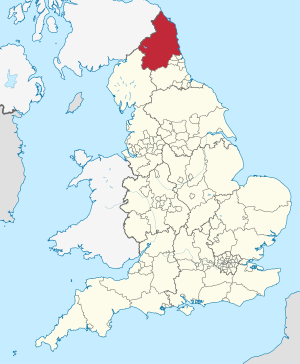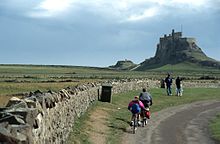Northumberland
| Northumberland county | ||
|---|---|---|
|
||
|
|
||
|
|
||
| Country | United Kingdom | |
| Part of the country | England | |
| region | North East England | |
|
|
||
| status | Ceremonial County and Unitary Authority | |
|
|
||
| Ceremonial county | ||
|
|
||
| Unitary Authority | ||
| Administrative authority | Northumberland County Council | |
| Administrative headquarters | Morpeth | |
| ISO-3166-2 | GB-NBL | |
| surface | 5,013 km² | |
| Residents | 320.274 | |
| was standing | June 30, 2018 | |
| ONS code | 00EM | |
| GSS code | E06000048 | |
| NUTS code | UKC21 | |
| Website | www.northumberland.gov.uk | |
|
|
||
Northumberland [ nɔːˈθʌmbələnd ] is a county and a Unitary Authority in England , on the border with Scotland . The name comes from its location north of the Humber River .
geography
At its greatest extent, the county extended as the Kingdom of Northumbria under King Edwin from the River Humber in the south to the River Forth in the north. Today , Northumberland, one of the traditional counties , is much smaller. The Northumberland coast is classified as a Heritage Coast .
administration
The traditional capital of the county was Alnwick . The administrative seat is now Morpeth .
Sports organizations in particular also include Newcastle upon Tyne and North Tyneside in Northumberland. The county officially borders on Tyne and Wear , County Durham , Cumbria and the Lieutenancy areas of Roxburgh, Ettrick and Lauderdale in Scotland .
On April 1, 2009, all districts and boroughs in Northumberland were abolished as part of the 2009 administrative reform and merged into the Northumberland Unitary Authority . Up to that time the county was divided into the six districts and boroughs Blyth Valley , Wansbeck , Castle Morpeth , Tynedale , Alnwick , Berwick-upon-Tweed .
history
Northumberland contains the largest number of cup-and-ring markings in the UK ( Roughting Linn , Dod Law, Lordenshaw, Weetwood Moor and Old Bewick ). These mostly Bronze Age markings are found on exposed rocks in the hills.
In the time before the Roman conquest there was already fighting between neighboring Celtic tribes. Northumberland has an eventful history and has been the scene of many wars between England and Scotland. This explains the many castles in Northumberland, u. a. well known ones like Bamburgh Castle , Dunstanburgh Castle , Warkworth Castle and Alnwick Castle .
Northumberland is also known as the cradle of Christianity because the island of Lindisfarne , also known as Holy Island , was where the Christianization of what is now England began. Monks from the Scottish island of Iona were sent to England to do missionary work and to build their monastery on Lindisfarne . The island is also home to the Lindisfarne Gospels , an illustrated collection of Latin hymns kept in the British Library in London . Also from Lindisfarne is St. Cuthbert , who entered Melrose Monastery in 651 and is buried in Durham Cathedral.
Bamburgh Castle, the historic capital of Northumberland, was a royal castle before uniting with Scotland under a monarch. Today the main towns in County are Alnwick , home to the Duke of Northumberland , and Morpeth, where the county’s administration is based.
The county was a center of Catholicism in England, but also of the Jacobites . Northumberland's history has been marked by rebellions against the government; this is shown e.g. B. in the pilgrimage of Grace and in the uprising of the north during the Tudor dynasty. These revolts were usually led by the Duke of Northumberland, a member of the Percy family . Most of these dukes, however, no matter what rebellion they led, were willing to betray their allies and give information to the government and get away with it. Two of them, Henry Percy, 1st Earl of Northumberland , and his son Harry Hotspur are also mentioned by Shakespeare . Northumberland became a kind of wilderness where outlaws and robbers, the Border Reivers , hid from the arm of the law. The county was mostly rural. After the unification of Scotland and England under King James I , Northumberland became more peaceful.
Archaeologists discovered one of Britain's largest Neolithic settlements in a quarry in Northumberland in 2005 during a routine archaeological investigation. The remains cover an area the size of two soccer fields. These are buildings, tools, pottery, ritual objects and a grave. The settlement near Milfield Village, north of Wooler, includes three buildings from the early Neolithic (around 4000 BC) and three buildings from the later Neolithic (around 3000 BC). The discovery of the remains of such a number of Neolithic buildings arranged together is very rare. According to Clive Waddington, it is one of the most important places of its kind as an opportunity to increase understanding of Britain's first farmers, their lifestyles and beliefs.
Northumberland today
Even today, Northumberland is still rural. It has the lowest population density in England . Northumberland gained its former importance through the border conflicts with Scotland. Today efforts are being made to attract tourists with a view to the beauty of the countryside both inland and on the coast, the many castles and the importance of Northumberland in the history of England. Attempts to raise awareness of the local culture to the level prevailing in Scotland have also been made, e.g. B. by founding a Northumbrian Language Society to preserve the unique dialects of this region ( Pitmatic and Northumbrian). The dialect of the Newcastle upon Tyne region is called Geordie .
towns and places
- Alnwick , Amble , Ashington
- Bamburgh , Bardon Mill , Belford , Berwick-upon-Tweed , Blyth , Brandon
- Chesters , Chollerford , Corbridge , Craster
- Dalton
- Elsdon , Embleton , Ellington
- Falstone
- Gateshead , Greenhaugh , Greenhead
- Haltwhistle , Hartley , Haydon Bridge , Hexham , Highfields , Horsley, Prudhoe , Housesteads
- Ingram
- Langley , Linton , Longhorsley , Lowick , Lynemouth
- Mindrum , Morpeth , Murton
- Netherton
- Once Brewed
- Rochester , Rothbury
- Seahouses , Shipley , Stonehaugh
- Vindolanda
- Warkworth , Wooler
Attractions
|
|
Web links
Individual evidence
Coordinates: 55 ° 15 ′ N , 2 ° 0 ′ W







